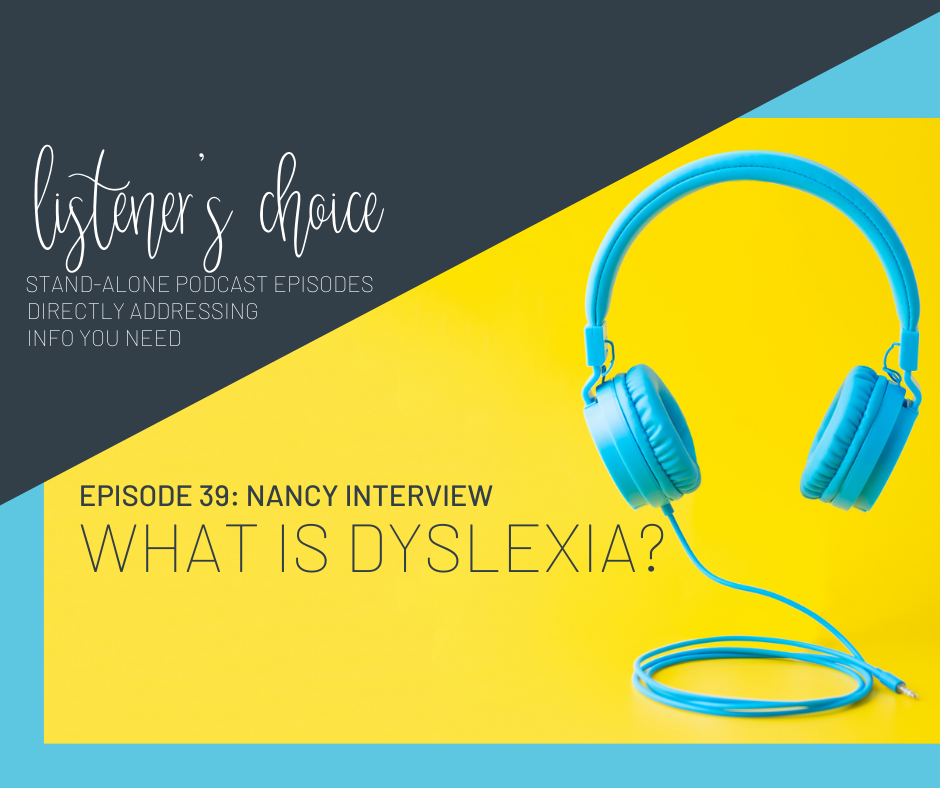What is dyslexia? Nancy Disterlic gives us an overview of what dyslexia is, what it looks like, and what we can do to help. Did you know that 1 in 5 people have this processing disability? That means either you or your friend (or both!) may be affected by this.
CLICK PLAY TO LISTEN!
Common Myths About Dyslexia
There are many common beliefs that some people have about dyslexia. Nancy goes into detail on some common misconceptions that she has heard throughout her career, and she debunks them. Hear the full episode on iTunes (episode 39).
Myth: Dyslexia is when someone reads backwards. Truth: Dyslexia is a processing disability.
Myth: Dyslexia is when people mix up the letters, read backwards, or see the letters floating. Truth: A commonality is that people with dyslexia can describe what they are trying to say, but cannot find the word they are wanting to use.
Myth: If you are diagnosed with dyslexia, you’ll have to go to intensive therapy. Truth: Dyslexia therapy isn’t one size fits all. Dyslexia affects everyone differently. Educators work hard to give individualized plans to make sure each person is set up for success.
Myth: People with dyslexia don’t do well in school. Truth: People with dyslexia (even undiagnosed) can develop coping mechanisms that help them in their everyday life.
What would you say to the doubting or skeptical parent?
Nancy gives several, great analogies to help parents understand that their child with dyslexia needs supports.
- If your child were diabetic, would you help them get the insulin they need?
- What about if your child had vision issues, would you help them get glasses?
- If your child had a broken leg, would you take them to the doctor?
All this to say, if your child had trouble processing information, would you be their advocate and get them the support they needed? Absolutely! Your child needs your help and support. Get their back.
What could dyslexia look like?
There is no one-size-fits-all for dyslexia. It is case by case, and so is the support. Dyslexia can look many different ways. Below are some identifiers that can be present in someone living with dyslexia:
- great oral learning abilities and communication
- ability to mimic & recall
- needing to read aloud to understand
- avoids print
- follows along with finger while reading
- letters b/d reversal
- excessive (too much) time to complete homework
- difficulty retrieving words
- history of dyslexia in the family
Tips for Parent & Teachers
Navigating life with dyslexia isn’t a quick fix. Below are ways you can support someone with dyslexia, especially if you are the parent or teacher of a dyslexia child. BONUS: if you don’t know anyone with dyslexia, this is just good practice for leading people!
- Choice & support: let’s them take ownership and gain independence
- Socratic method: create a safe environment for thinking
- Respect & love: do not use shame or sarcasm
- Educate yourself on what is developmentally appropriate for each age group
- “Chunk” directions: “How can i help you accomplish this?” Start with something they can do and work from there.
- Well worded questions: without attacking, try using a phrase like, “What would ____ look like?”
- Empathize: think about your most insecure place… that’s how a dyslexic kid feels when you make them read
- Social emotional development: be real, walk through challenges, work through their strengths so they have a correct perspective
- audiobooks: or read aloud (even at a young age). This helps them become more independent and helps build stamina. Be sure to stop and talk frequently
- Encourage them: Here’s an article on how to do this!
- Have a language rich environment: read and speak to your children as much as possible
Links from the Show
- The Secret Life of the Dyslexic Child (book, affiliate link)
- Dyslexia & Education Pins (Pinterest)
- Switch on Your Brain (book, affiliate link)
- Instill grit by speaking (article)
- Late, Lost & Unprepared (book, affiliate link)
- Crucial Conversations (book, affiliate link)
- The Gifts of Imperfection by Brene Brown (book, affiliate link)
- Region 10 Dyslexia Helpline
- International Dyslexia Association
- Academic Language Therapy Association


